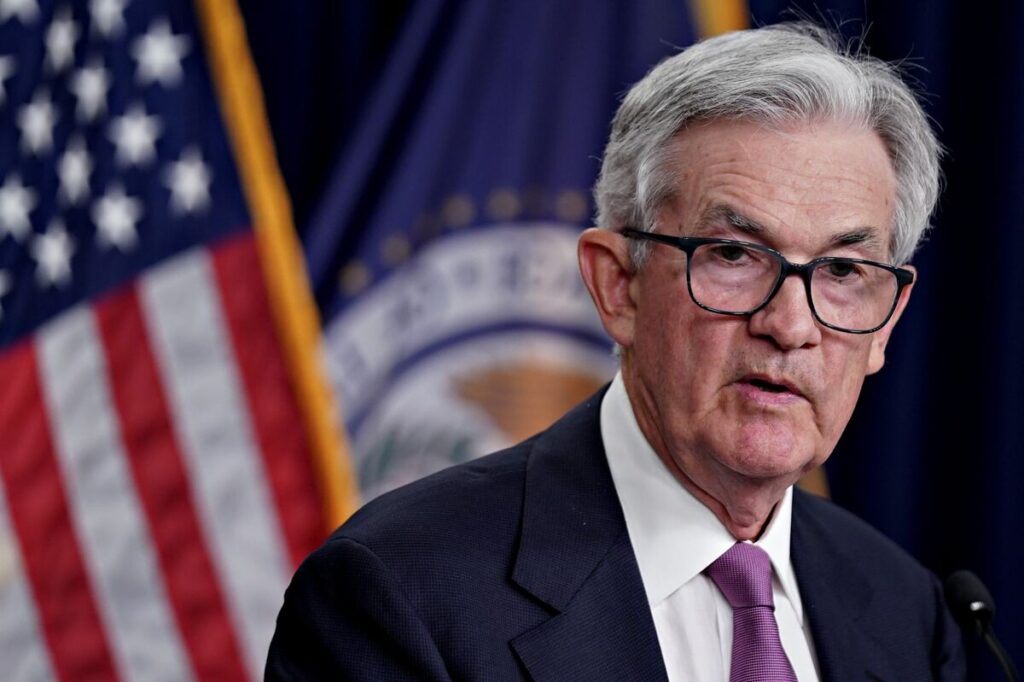Market maker Citadel Securities recommended that the SEC impose stricter rules on decentralized finance platforms offering tokenized stocks.
The firm submitted a letter to the SEC on Tuesday, arguing that DeFi developers, smart-contract coders, and self-custody wallet providers should not receive “broad exemptive relief” for facilitating trading of tokenized US equities.
Citadel claimed that these platforms likely fall under the definitions of an “exchange” or “broker-dealer” and must comply with securities laws if offering tokenized stocks.
Regulatory Concerns and Crypto Backlash
The firm warned:
“Granting broad exemptive relief to facilitate the trading of a tokenized share via DeFi protocols would create two separate regulatory regimes for the trading of the same security.”
“It would be the exact opposite of the ‘technology-neutral’ approach taken by the Exchange Act.”
The letter was submitted as part of the SEC’s request for feedback on tokenized stock regulation.
It quickly drew strong reactions from the crypto community.
Lawyer and Blockchain Association board member Jake Chervinsky remarked on Thursday:
“Whoever thought Citadel would be against innovation that removes predatory, rent-seeking intermediaries from the financial system?”
He added:
“Oh, right, literally every single person in crypto.”
Industry Voices Warn Against Overreach
Uniswap founder Hayden Adams said:
“It makes sense the king of shady TradFi market makers doesn’t like open source, peer-to-peer tech that can lower the barrier to liquidity creation.”
Summer Mersinger, CEO of the Blockchain Association, criticized the approach, stating:
“Regulating software developers as if they were financial intermediaries would undermine US competitiveness, drive innovation offshore, and do nothing to advance investor protection.”
She urged the SEC to focus on actual intermediaries who stand between users and their assets.
SIFMA’s Position
The Securities Industry and Financial Markets Association echoed concerns over DeFi carve-outs.
While supporting innovation, SIFMA stressed that tokenized securities must adhere to the same investor protections applied to traditional finance.
Citadel had previously told the SEC’s Crypto Task Force in July that tokenized securities must provide “real innovation and efficiency to market participants, rather than through self-serving regulatory arbitrage.”
The CME Group has introduced a broad set of cryptocurrency benchmarks intended to bring more structure and transparency to digital-asset markets.
The new collection of indices offers pricing references and volatility metrics for major tokens, giving institutional traders access to tools similar to those long used in equities, commodities and other financial markets.
CME confirmed the suite covers leading cryptocurrencies including Bitcoin, Ether, Solana and XRP.
Volatility Benchmarks Take Center Stage
A key element of the rollout is the addition of Bitcoin volatility benchmarks designed to measure expectations of future price swings.
These benchmarks track implied volatility drawn from Bitcoin options markets, including contracts tied to Micro Bitcoin futures.
CME describes the product as serving a similar function to the VIX in equity markets, offering an estimate of how much movement traders anticipate over the next 30 days.
While the volatility benchmarks are not tradable products on their own, they provide a unified reference point that traders can use for risk management, options pricing and portfolio adjustments.
Why the New Benchmarks Matter
Volatility indices play a major role in global financial markets, and their introduction to crypto reflects the maturity of digital-asset derivatives.
They allow analysts and traders to quantify uncertainty more precisely.
They help identify when markets may be preparing for sharper swings.
And they underpin advanced strategies that depend on expectations of future volatility rather than price direction.
The CME benchmarks are intended to standardize these processes in crypto markets, which until now have used fragmented data from multiple exchanges.
Institutional Activity Continues to Grow
Demand from institutions has expanded steadily in recent years as crypto derivatives gained traction alongside the growth of spot Bitcoin exchange-traded funds.
Even before the ETF era, institutions were active in crypto futures and options, but the arrival of regulated spot products has accelerated interest in complementary hedging tools.
CME reported that the third quarter delivered a significant milestone as combined futures and options trading volume across its crypto products surpassed $900 billion.
Average daily open interest reached more than $31 billion during the period, marking a fresh record and signaling consistent capital participation.
Open interest represents contracts that remain active rather than closed or rolled over, making it a useful measure of conviction and liquidity.
Broader Derivatives Market Expands
Institutional derivatives activity also broadened beyond Bitcoin.
Ether and Micro Ether futures saw substantial increases in trading volume, suggesting a wider set of market participants are engaging with alternative crypto assets through CME-regulated products.
The growth helps reinforce the need for standardized reference rates that align with the level of institutional involvement.
A Step Toward Market Maturity
CME’s move reflects a long-term trend toward the professionalization of crypto trading infrastructure.
As more institutions incorporate digital assets into multi-asset strategies, demand grows for familiar analytical tools that reduce uncertainty and support risk-adjusted decision-making.
The new benchmarks offer a consistent measurement framework that may help strengthen confidence in crypto derivatives as the asset class continues evolving.
Japan’s government and ruling coalition have signaled support for a sweeping reform of the nation’s crypto tax system, backing plans to cut the maximum tax rate on digital-asset profits to a flat 20%.
The changes, originally proposed by Japan’s Financial Services Agency in November, now have political momentum heading into 2026.
Under the plan, the FSA intends to introduce a bill during the regular Diet session in early 2026.
The shift would bring crypto taxation in line with equities and investment trusts, which already benefit from a uniform 20% rate.
Current System Burdens Crypto Traders With High Rates
Under existing rules, profits from crypto trading are categorized as “miscellaneous income,” meaning individuals and businesses face income-based taxation.
The rate can range from as low as 5% to as high as 45%, depending on annual earnings.
High-income earners may also be subject to an additional 10% inhabitant tax, pushing the total burden even higher.
This system has long been criticized for discouraging both investment and innovation in Japan’s digital-asset sector.
By contrast, gains from equities and investment funds are treated separately from income tax and taxed at a consistent 20%.
Proposed Changes Aim to Boost Domestic Crypto Activity
Nikkei Asia reported that the proposed reduction is part of a broader plan to place crypto assets within a “solid investor-protection framework” while aligning them more closely with other financial products.
The reforms are expected to increase domestic participation by removing one of the biggest deterrents facing retail and institutional investors.
If passed, the new structure could make Japan one of the more competitive major markets for digital-asset investing.
FSA Bill Targets Oversight, Transparency and Market Integrity
Alongside the tax reduction, the FSA’s upcoming legislation will include new rules aimed at tightening market oversight.
These measures will reportedly address the handling of non-public information, enhance disclosure requirements and introduce safeguards to reduce risks in crypto trading.
The goal is to strengthen regulatory protections while allowing the industry to grow under clearer, more favorable conditions.
Lobbying Efforts Show Signs of Paying Off
For nearly three years, the Japan Blockchain Association has pushed for a flat-rate tax structure for crypto assets.
In 2023, the group published a formal letter urging the government to adopt a 20% rate similar to those used for other investments.
“This letter requests a review of tax on crypto assets, which is the biggest hurdle for companies operating Web3 businesses in Japan and a disincentive for the public to actively own and use crypto assets,” the letter reads.
While the FSA has not confirmed whether the association’s lobbying directly influenced its decision, the agency began publicly considering reforms in late 2024.
Industry Prepares for a New Phase of Growth
If the legislation passes in 2026, Japan’s crypto market may experience a substantial increase in trading activity.
Lower taxes, combined with stronger investor protections, could attract both domestic users and international companies seeking regulatory stability.
The reform would represent one of Japan’s most significant steps toward modernizing its financial landscape and reaffirming its position as a major hub for blockchain innovation.
Bitcoin is showing an unusually strong resemblance to its 2022 bear-market behavior, with analysts noting that the price pattern in 2025 is aligning almost perfectly with previous cycle lows.
With the year nearing its end, the cryptocurrency remains down around 36% from its all-time high despite earlier expectations that bullish momentum would accelerate into December.
Network economist Timothy Peterson has been among the most vocal in highlighting how closely the current trajectory matches that of 2022.
“2H2025 Bitcoin is the same as 2H2022 Bitcoin,” he wrote in a recent post on X.
Correlation Metrics Reach Unprecedented Levels
Peterson’s analysis shows that the daily correlation between 2025 and 2022 market action sits at roughly 80%.
The monthly correlation has climbed even higher, hitting an extraordinary 98%.
Charts accompanying his research indicate that if the trend remains intact, Bitcoin may not see a significant rebound until sometime in the first quarter of 2026.
These findings have unsettled investors who hoped the market would rebound heading into the holiday period.
Peterson recently summarized November’s performance with blunt clarity.
“It feels bad because it is bad,” he wrote, adding that “this month ranks in the bottom 10% of daily price paths since 2015.”
Historical Patterns Suggest December May Bring More Losses
Bitcoin’s negative performance in November has historical implications.
Data shows that when the cryptocurrency posts a “red” November, December often follows with further declines, though usually with reduced severity.
With only weeks remaining in the year, traders are now weighing whether macro-driven optimism could deliver an end-of-year “Santa rally” or whether the market will continue mimicking 2022’s prolonged slump.
Shift in Macro Environment Boosts Equities
While crypto endured a challenging month, broader financial markets have shown signs of recovery.
Figures reported by The Kobeissi Letter indicate that US equity funds have witnessed $900 billion in inflows since November 2024, with $450 billion arriving within the last five months alone.
The publication noted: “Put differently, equities have attracted more inflows than all other asset classes COMBINED.
Equity inflows remain remarkably strong.”
This surge contrasts with the relatively muted performance of other asset classes, creating a divergence between stock-market sentiment and crypto-market behavior.
ETF Inflows Signal Potential Crypto Stabilization
Despite the recent sell-off, new data suggests that institutional crypto participation may be recovering.
Spot Bitcoin ETFs recorded $220 billion in inflows during Thanksgiving week, a noteworthy improvement after weeks of consistent redemptions.
Spot Ether ETFs saw a similar turnaround, adding $312 million over the same period.
These inflows may indicate that institutional investors are positioning ahead of a possible early-2026 recovery.
Bitcoin may have significant upside from its current levels, according to crypto researcher André Dragosch, as the asset appears out of step with the forward macroeconomic outlook.
“The last time I saw such an asymmetric risk-reward was during COVID,” Dragosch, head of research at Bitwise Europe, said in a post on X on Friday.
He was referring to March 2020, when global pandemic fears caused Bitcoin’s price to tumble from around $8,000 to below $5,000.
Current Setup Mirrors Extreme Past Conditions
Dragosch highlighted that Bitcoin’s current conditions mirror the extreme risk-reward scenario seen during the early COVID period.
He noted that the cryptocurrency is “pricing in the most bearish global growth outlook since 2022,” pointing to aggressive quantitative tightening from the US Federal Reserve and the collapse of crypto exchange FTX.
“Bitcoin is essentially pricing in a recessionary growth environment,” Dragosch said, adding that the asset has already accounted for “a lot of the bad news.”
US Treasury Secretary Scott Bessent reassured citizens on Sunday that the United States is not at risk of entering a recession in 2026.
Bitcoin Struggles Despite Market Hopes
Bitcoin’s price has underperformed relative to market expectations over the past month.
After hitting all-time highs of $125,100 on October 5, the cryptocurrency entered a downtrend following a $19 billion liquidation event on October 10.
This sell-off occurred shortly after US President Donald Trump announced 100% tariffs on Chinese goods, further impacting market sentiment.
Bitcoin fell below the psychological $100,000 level on November 13 and has yet to reclaim it.
The price briefly dipped under $90,000 on November 20, though it quickly rebounded above this level a few days later.
According to CoinMarketCap, Bitcoin has declined 17.33% over the past 30 days.
Continued Adoption
Despite the pullback, Bitcoin and other cryptocurrencies are continuing to be adopted in the real world. For example, cryptocurrencies are continuing to be used for secure withdrawals in crypto casinos – and this adoption is unlikely to slow down even in the face of a bear market.
Even countries such as the UAE, where gambling has long been banned, are starting embrace online casinos and blockchain-based gambling platforms. For instance, the GCGRA recently authorized Play 971 as the first online casino in the UAE.
Optimism from Macro Drivers
Dragosch believes global growth is likely to recover, supported by the effects of preceding monetary stimulus.
He compared the current environment to the post-COVID period, suggesting similar macro forces could support growth well into 2026.
“I genuinely think we’re staring at a similar macro setup right now,” Dragosch said.
Market Participants Eye a Rebound
Not all crypto investors are convinced that a prolonged bear market has begun.
Crypto trader Alessio Rastani told Cointelegraph that the recent price drop may not indicate the start of a long-term downturn.
Instead, Rastani argued that historical data points to recurring setups that have preceded strong rallies roughly 75% of the time.
Meanwhile, BitMine chair Tom Lee expressed confidence that Bitcoin could reclaim the $100,000 mark by the end of the year.
He added that the cryptocurrency might even reach new all-time highs, reflecting ongoing optimism among certain market participants.
Crypto-linked stocks saw strong upward movement on Friday as traders reacted to a sharp rise in prediction-market forecasts pointing to a December interest-rate cut.
The odds listed on Polymarket rose to 87% — the highest level recorded this month — and that shift in expectations drove renewed appetite for crypto-exposed equities.
Several U.S.-listed Bitcoin miners led the day’s advance.
Cleanspark, Riot Platforms and Cipher Mining each recorded gains during Friday’s session, adding to a streak of double-digit increases over the previous five days.
Circle, the issuer of USDC, also made notable progress with nearly a 10% jump in early trading.
Strategy, backed by Michael Saylor, alongside Coinbase, logged more modest increases but still participated in the broader market move.
Bitcoin itself added around 7% over the past week after briefly dipping to roughly $82,000 on Nov. 21.
Interest-Rate Commentary Drives Market Volatility
The rapid swings in prediction-market pricing throughout November have largely been tied to comments from Federal Reserve officials.
On Oct. 29, Fed Chair Jerome Powell stated that a December rate cut was “not a foregone conclusion,” which investors interpreted as a hawkish signal.
That single remark led to prediction-market odds collapsing from 89% the previous day to around 22% by Nov. 20.
The sentiment reversal began on Nov. 17 after Fed Governor Christopher Waller indicated the central bank should actively consider a rate cut next month.
He argued that “the labor market is still weak and near stall speed” and that inflation appeared “relatively close” to the Fed’s 2% target.
The remarks immediately reshaped expectations and helped drive the latest price rally in crypto-linked assets.
Prediction Markets Gain Influence Across Industries
Prediction markets have expanded significantly this year as more companies and investors embrace the model.
Platforms such as Polymarket and Kalshi have attracted users by allowing wagers on political developments, financial outcomes and major global events.
Polymarket recently secured a multi-year partnership to act as the official prediction-market platform for both the UFC and Zuffa Boxing.
The company has also grown through other strategic partnerships that broaden the use of prediction contracts across entertainment and sports.
Meanwhile, Kalshi has continued its own expansion after attracting major investment rounds that substantially increased its valuation.
Both platforms have reported surging user activity as traders increasingly use prediction markets to anticipate economic decisions, including those from the Federal Reserve.
Trading Apps Join the Prediction-Market Trend
The rapid rise of prediction markets has also caught the attention of larger trading platforms.
Robinhood recently confirmed that prediction markets have become one of its fastest-growing revenue categories.
The platform said that more than one million users have already traded billions of contracts since the feature launched earlier this year.
Rumors have also circulated that Coinbase is developing a prediction-market platform of its own, following the appearance of early interface images.
The acceleration of these platforms underscores a broader trend: traders across traditional and crypto markets are relying more heavily on probabilistic pricing tools to interpret and react to policy shifts.
As expectations for a December rate cut climb, crypto-linked stocks appear positioned to remain sensitive to any new signals from the Federal Reserve.
Bitcoin held its ground above the $90,000 support level on Thursday, benefiting from a pause in US trading activity during the Thanksgiving holiday and sparking fresh optimism that a more sustained recovery may be forming.
Data from market tracking platforms showed BTC/USD stabilizing after hitting weekly highs near $92,000 earlier in the day.
The lack of a Wall Street session removed short-term selling pressure, offering bulls a temporary window of relief.
Traders said attention now turns to the critical resistance zone near the 2025 yearly opening price at just over $93,000.
Crypto analyst Michaël van de Poppe described the area as a pivotal barrier that could determine Bitcoin’s next major move.
“If this levels breaks, Bitcoin is back up to $100K,” he wrote on X.
He added that the latest upswing represented “a pretty strong bounce upwards,” but cautioned he wanted to see “some consolidation” before a decisive breakout attempt.
Market liquidity indicators suggest that a substantial cluster of resting orders sits between $97,000 and $98,000.
Trader Daan Crypto Trades identified this zone as a key near-term upside target, noting that heavy sell-offs from earlier in the month created a “big liquidity pocket” at that level.
He pointed out that the region also aligns with a horizontal price structure that could attract both short-covering and breakout buyers.
Some traders maintain that a retest of $88,000 would not be unexpected, with van de Poppe saying he “wouldn’t mind” such a move and arguing that the broader crypto bull cycle remains “far from over.”
On-chain indicators show improving conditions underneath the surface.
J. A. Maartunn, a contributor to analytics platform CryptoQuant, reported that spot taker cumulative volume delta — a measure that has hovered in negative territory — has recently moved back toward neutral.
He described the shift as a “significant step forward” for market recovery.
Earlier this month, analysts highlighted the negative trend in spot taker CVD as one of several risk factors as Bitcoin traded above $100,000.
CryptoQuant researchers now argue that data across spot, futures, and on-chain markets reflects the unwinding of what they termed a “leveraged phase.”
In a recent analysis, XWIN Research Japan wrote that the market is showing signs of longer-term capital returning, citing a retail futures activity indicator that has flipped green and historically aligns with key market turning points.
The current stabilization comes after a volatile stretch for Bitcoin.
Earlier in November, the market wrestled with heavy selling and rapid liquidations tied to broader macro uncertainty and rising geopolitical tensions.
Despite that turbulence, Bitcoin’s ability to hold $90,000 suggests buyers are actively defending strategic levels as the year heads into its final weeks.
With holiday-related lower volumes and upcoming macro events likely to influence market direction, traders say Bitcoin’s next moves could define the opening narrative for 2026.
For now, the return of bullish sentiment, improving liquidity conditions, and on-chain stabilization are raising hopes that the recent rebound may be more than a temporary pause.
Bitcoin (BTC) has begun a steady recovery after last week’s steep correction, moving back toward the $87,000 to $90,000 range.
The cryptocurrency fell from $106,000 to $80,600 in just 10 days, prompting renewed speculation over whether BTC has reached a local bottom.
The rebound comes even as major whale holders continue to sell their BTC, though mid-sized holders and long-term accumulators are showing increased conviction in the market.
Accumulation and Distribution Patterns
Onchain analytics reveal significant differences in behavior between various BTC holder cohorts.
Wallets holding more than 10,000 BTC, along with institutional investors holding 1,000 to 10,000 BTC, acted as consistent sellers during the correction, contributing to downward pressure.
Retail wallets, defined as holding less than 10 BTC, also sold off over the past 60 days, providing little market support.
In contrast, mid-sized holders in the 10–100 BTC and 100–1,000 BTC ranges accumulated BTC, helping absorb sell-side pressure and stabilize prices.
Demand from Bitcoin “accumulator addresses” hit a record 365,000 BTC on Nov. 23, up from 254,000 BTC on Nov. 1, indicating growing long-term confidence among certain investors.
Futures Market and Short Squeeze Potential
The recent BTC crash was largely fueled by futures markets, where cascading long liquidations, forced selling, and margin calls pushed BTC into the $80,000 range.
CryptoQuant data shows that traders attempting to long the correction have been squeezed out, with daily funding rates briefly turning negative.
Analyst Darkfost warned that if shorts continue to pile up while BTC gradually rises, the market could enter a “disbelief phase,” creating the conditions for a sharp short squeeze.
Long liquidation heatmaps from Hyblock Capital indicate $2.6 billion in long liquidations at $80,000, while short liquidations surged over $8.4 billion near $98,000, showing the influence of liquidity bands at $94,000, $98,000, and $110,000.
These dynamics suggest that BTC’s rebound may continue toward the $90,000 mark as mid-sized holders and accumulators provide steady support.
BlackRock’s head of digital assets, Robbie Mitchnick, has suggested that most major asset managers are not viewing Bitcoin through the lens of day-to-day payments when evaluating its role in portfolios.
In a recent podcast appearance, Mitchnick emphasized that institutions are largely focused on Bitcoin’s store-of-value appeal rather than its potential as a global payment technology.
“I think for us, and most of our clients today, they’re not really underwriting to that global payment network case,” Mitchnick said.
“That’s sort of maybe out-of-the-money-option-value upside,” he added.
The comments highlight a continued divide between the vision of Bitcoin as digital cash and the practical considerations driving institutional adoption today.
Focus Remains on the Digital Gold Narrative
Mitchnick explained that the speculative nature of Bitcoin’s payment utility means investors remain more committed to the asset’s “digital gold” narrative.
He said Bitcoin may still evolve into a widely used payment tool, but that scenario involves more uncertainty than its role as a store of value.
He described the payments thesis as “a little bit more speculative,” adding that institutions prioritize the resilience and long-term investment use case rather than transactional adoption.
Significant Scaling Needed for Bitcoin Payments
According to Mitchnick, substantial technical progress would be required before Bitcoin could realistically compete with traditional payment networks.
“There’s a lot that needs to happen in terms of Bitcoin scaling, Lightning, and otherwise to make that possible,” he said.
The comments echo broader industry concerns around the future of Bitcoin scaling solutions.
Earlier analyses, including an August 2024 report from Galaxy Research, warned that many Bitcoin layer-2 networks — especially “rollups” — may struggle over the long term, despite current enthusiasm around faster and cheaper transaction layers.
Other blockchain networks are being used for a variety of real-world purposes, including sending payments and powering online bingo sites.
Stablecoins Surging Ahead in Payments Sector
While Bitcoin’s payment future remains uncertain, Mitchnick said stablecoins have already demonstrated clear adoption.
He described the sector as “hugely successful,” noting that stablecoins offer “massive product market fit as a payment instrument as a way of moving value around efficiently.”
Mitchnick said stablecoins are poised to grow well beyond their existing uses in trading and decentralized finance.
“Stablecoins have the potential to greatly expand where they are used today, going beyond just the sort of crypto trading ecosystem and DeFi to actually doing retail remittance payments, corporate, multinational, cross-border transactions, and capital market settlement activity,” he said.
He added that while Bitcoin could compete in certain payment categories — such as retail remittances — institutional investors still view that scenario as uncertain.
“At some point it is possible, but it’s a more speculative thing to underwrite at this point,” he said.
Stablecoin Momentum Influencing Long-Term Bitcoin Forecasts
The rapid growth of stablecoins has already influenced how analysts model Bitcoin’s long-term value.
ARK Invest CEO Cathie Wood recently said that the sector’s accelerating expansion forced her to revise her earlier projections for Bitcoin’s 2030 valuation.
“Stablecoins are usurping part of the role that we thought that Bitcoin would play,” she said.
Wood previously expected Bitcoin to hit $1.5 million by the end of the decade, but now believes reducing that estimate by roughly $300,000 may be justified given stablecoin adoption.
“I think emerging markets are huge in this regard and we’re starting to see institutions in the United States focused on new payment rails,” she said.
Industry Leaders Expect Full Transition to On-Chain Money
The trend toward stablecoin-based payment systems appears to have strong support among industry builders.
Tether co-founder Reeve Collins told Cointelegraph in September that he expects “all currency” to transition into stablecoin form by 2030, reflecting a broader shift toward on-chain financial infrastructure.
That outlook contrasts with the more cautious stance on Bitcoin’s payment potential, underscoring how digital assets may take on distinct roles within future financial systems.
Bitcoin investor Strategy is facing scrutiny after a steep decline in its share price this year, but long-term data shows the company’s Bitcoin-driven model remains far more resilient than short-term charts suggest.
Google Finance data shows Strategy’s stock has dropped nearly 60% over the past year and more than 40% year-to-date.
The stock was trading near $300 in October but has since fallen to around $170.
Despite Declines, Bitcoin Holdings Still in Profit
Some investors have interpreted the slump as evidence that Strategy’s approach has been “exposed.”
However, BitcoinTreasuries.NET data shows the company acquired its Bitcoin at an average cost of $74,430.
With Bitcoin trading near $86,000, Strategy remains up about 16% on its overall Bitcoin purchases.
The company’s long-term stock performance also paints a different picture.
Over the past five years, Strategy shares have climbed more than 500%.
For comparison, Apple gained 130% over the same period, while Microsoft increased by 120%.
Even over two years, Strategy’s stock rose 226%, outperforming Apple’s 43% and Microsoft’s 25%.
Why Investors Are Shorting Strategy
The recent price decline may have less to do with Bitcoin’s fundamentals and more to do with how institutional investors hedge their crypto exposure.
In a CNBC interview, BitMine chairman Tom Lee said Strategy has become the most convenient vehicle for hedging Bitcoin.
“Someone can use MicroStrategy’s options chain, which is so liquid, to hedge all of their crypto,” he said. “The only convenient way to hedge someone’s long is to short MicroStrategy or buy puts.”
This dynamic has effectively turned Strategy into a pressure valve for the broader crypto market, absorbing volatility, hedges and short positions that may not reflect its underlying business strategy.
Strategy Expands Its Bitcoin Holdings
Despite the turbulent market, Strategy continues building its Bitcoin treasury.
Chairman Michael Saylor reaffirmed his commitment to the company’s approach, writing on X that he “won’t back down.”
On Nov. 17, the company announced the purchase of 8,178 BTC for $835.6 million.
The acquisition — significantly larger than its typical weekly purchases — brought Strategy’s total holdings to 649,870 BTC, valued at nearly $56 billion.
Liquidity Slowdown Adds to Market Pressure
On Nov. 6, crypto market-maker Wintermute attributed recent market weakness to slowing liquidity flows across stablecoins, exchange-traded funds and digital asset treasuries.
The firm said inflows in all three areas had flattened, contributing to widespread price pressure.
Data from DefiLlama shows digital asset treasury inflows fell from almost $11 billion in September to just $2 billion in October — an 80% decline following the liquidation of around $20 billion in crypto positions.
Inflows decreased further in November, reaching about $500 million as of Monday, marking a 75% drop from October.
Despite these conditions, Strategy’s long-term performance continues to outpace major tech benchmarks, underscoring the company’s conviction in Bitcoin even amid near-term turbulence.












